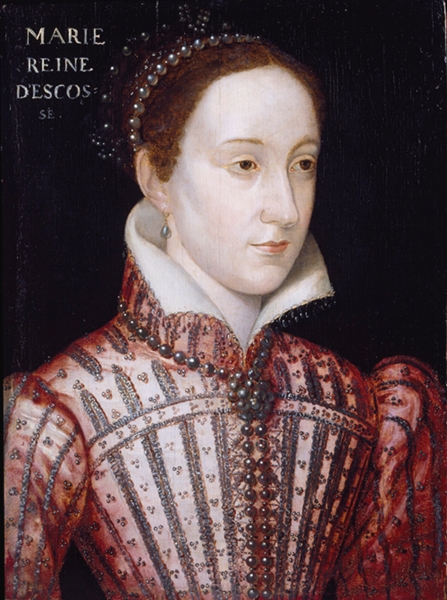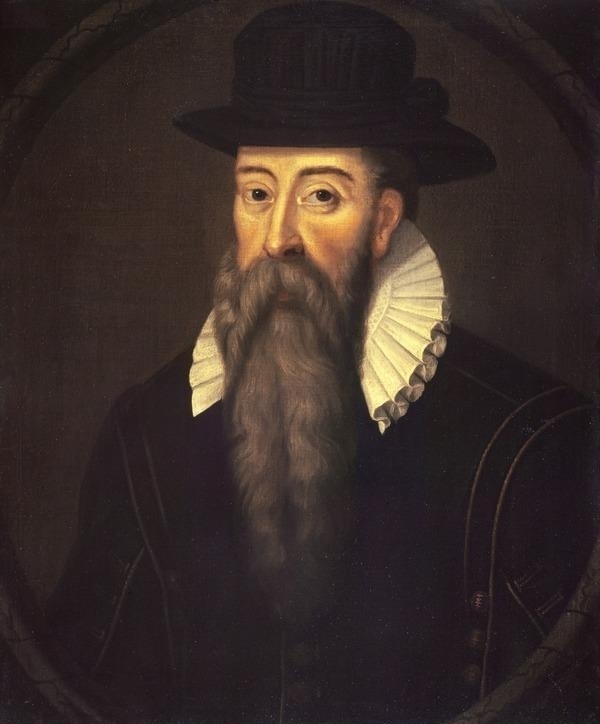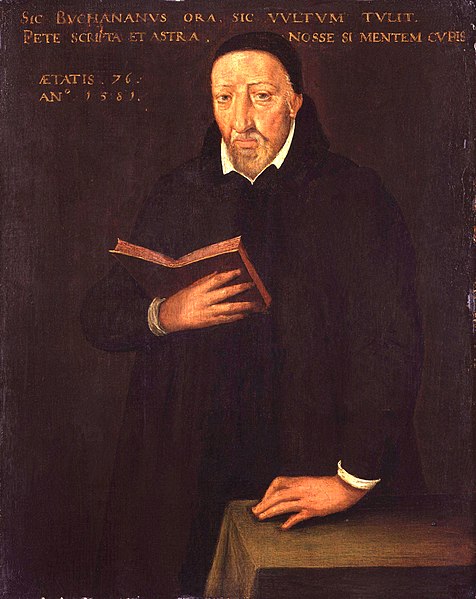The King’s Mother
 |
| Mary Queen of Scots |
James VI of Scotland was only thirteen months
old when he ascended the throne of Scotland. His 24 year old mother Mary had been forced to abdicate after
the murder of James’ father Henry, Lord Darnley.
The former
queen of France, more French than Scottish, returned to her country upon the
death of her first husband Francis II. In a haze of sexual attraction Mary
married the 20 year old Darnley in 1565 in opposition to her advisers and to
the queen in England, Elizabeth[i].
Mary soon had
cause to hate her jealous, lonely and arrogant husband. Darnley isolated, by
Mary’s courtiers, joined with her enemies; he was involved in the murder of Mary’s
secretary David Rizzio in March 1566; an event which took
place in front of the pregnant queen. James was born three months later on 19th
June after a long and difficult labour.
David Rizzio
The Young Prince
In the
afternoon Mary was visited by a crush of noblemen wanting to congratulate her
on James’ birth. In response to rumours that the child was not Darnley’s[ii] Mary pushed for
recognition from her husband;
‘My Lord, here I protest to
God, and as I shall answer to Him at the great Day of Judgement, this is your
son and no other man’s son. And I am desirous that all here bear witness, for
he is so much your son that I fear it will be the worse for him hereafter.’[iii]
Mary and Darnley
She then
informed Sir William Stanley, an English envoy;
‘This is the son whom I hope
shall first unite the two kingdoms of Scotland and England.’[iv]
James was
christened on 17th December 1566 at Stirling Castle, according to the Catholic rites; Darnley did not attend.
The new Comte de Brienne[v] stood proxy for King Charles of France, one of James’ godparents.
The Englishman, proxy for Elizabeth, stood outside the chapel door away from possibility
of Papist contagion.
Husband Number Three
Kirk o'Field
Having tired
of the Darnley Mary turned to the Earl of Bothwell, who arranged Darnley’s murder. The
young king consort was recovering from a bout of either smallpox or syphilis
and was living apart from his wife when he was blown up at Kirk o’ Field on
10th February 1567.
Elizabeth
was not impressed by the death of one of her subjects;
‘The Queen expresses sorrow
at the death of the King [Darnley], and she thinks that, although he married
against her wish, yet, as he was a royal personage and her cousin, the case is
a very grave one, and she signifies her intention to punish the offenders.’[vi]
Loch Leven castle
Marrying
Darnley’s murderer turned the majority of her lords against Mary. Following the
defeat of her and Bothwell’s army at Carberry Hill on 15th June Mary’s
brother the Earl of Moray was made Regent for James while Mary
was imprisoned in Loch
Leven castle[vii].
On 2nd May 1568 Mary escaped and on 13th May the army
that Bothwell had hastily put together was defeated at the battle of Langside. On 16th May Mary landed in England and
two days later was confined at Carlisle castle[viii].
The Young King
Earl of Moray
James saw
his mother for the last time in April 1567; the small child, around eleven
months old, can never have had any memories of his mother. On 23rd
January 1570 James’ uncle and Regent was assassinated[ix] and then his grandfather,
the Earl of Lennox became Regent. Lennox died in
September 1571 wounded in a foray. The post of Regent was then taken by the
Earl of Mar, who died of natural causes in October1572[x].
The Earl of Mar
The Earl of Mar was appointed Governor of the young
prince and his upbringing was left to the Countess of Mar, a strict and harsh
surrogate parent. James was brought up strictly in a loveless environment; his
material wants were not neglected, as a baby James had a nurse and four persons
to rock his cradle. His bed was curtained in black and his pillows edged with
black. But despite the dour household James was to find a friend in Mar’s son,
whom James nicknamed Jocky o’Sclaitis; Jocky was eight years older than the
young king.
James had
weak lower limbs and until he was seven could barely walk[xi]. He also had problems
eating and drinking as a child and may have suffered from cerebral palsy. James
may also have suffered from ADHD[xii], as evidenced by his
restlessness, inability to concentrate on routine work and obsession with
hunting. He had an allegedly lion shaped birthmark on his arm.
Sir Edward
Wotton[xiii] saw in James;
‘In his eyes and in the
outward expression of his face…..a certain natural goodness.’[xiv]
While the
English courtier Roger Wilbraham[xv] claimed that James had;
‘The sweetest, pleasantest
and best nature that ever I knew.’[xvi]
Education
George Buchanan
One of
James’ tutors, the gentle Peter Young, was much liked by his pupil and he eventually moved to
London with James in 1603 and took charge of the young Charles. But the senior
tutor was George Buchanan, a brilliant but embittered and
brutal old man, who bitterly hated Mary and was said to exact vengeance against
those who offended him, including the young king.
Buchanan
even claimed that Mary wanted to give James into the care of Bothwell and that
she was prepared to consider infanticide;
‘Bothwell did not consider
it to his own security to protect a boy [James] who might one day become the
avenger of his father’s death; and he wanted no other to stand in the way of
his own children in line of succession to the throne. The Queen, who could
refuse him nothing, personally undertook to have the boy brought back.’[xvii]
This was
totally untrue and Mary had left strict instructions that James was to be
surrendered to no-one other than herself.
The author
of Detectio Mariae Reginae was
unlikely to encourage James to think well of his mother[xviii]. The toys that Mary
sent her child never reached him and as an adult James was to deal with the
issue of his mother unemotionally. Just before Moray’s death Mary sent her son
a pony and a letter that Elizabeth did not allow out of England;
‘Dear Son, I send three
bearers to see you and bring me word how ye do, and to remember you that ye have
a loving mother that wishes you in time to love know and fear God.’[xix]
Through use
of the rod Buchanan instilled more learning in the young king, who ended up
resenting the old man and much of what he stood for; James wrote a number of
theological and political works on the divine right of kings that countered
Buchanan’s views[xx].
But Buchanan taught James that his mother had murdered his father, that she was
an adulteress and worst of all was a standard bearer of a wicked and heretical
religion; lessons that were never to leave him.
the young James
James’ day
would start with prayers and then a lesson of Greek. This was followed by
breakfast and then a Latin lesson. After dinner James would study composition,
then arithmetic and cosmography[xxi] or dialectics or
rhetoric. By the age of eight James could discourse on knowledge and ignorance
to the astonishment of his auditors. He would do so while walking up and down
holding Lady Mar’s hand. Naturally in this Calvinistic household James’
religious education was not neglected and his interest in religion was to be
life-long.
Buchanan, the
finest Latin scholar in Europe, had his five year old pupil address the
Scottish parliament in Latin within a year of commencing his studies. After the
speech the observant and necessarily precocious child noticed a hole and
informed his lairds;
‘This parliament has a hole
in it.’[xxii]
A few days
later James’ grandfather the Earl of Lennox was brought back to the castle,
dying of wounds received during fighting with his mother’s supporters. Mar was
replaced by the Earl of Morton, one of Darnley’s murderers.
On the 4th
March 1578 the Earls of Atholl and Argyll appeared in full armour in Stirling
castle and advised James that, at the age of nearly twelve, he was now old
enough to rule for himself and that James should abolish the Regency. James was
nothing loath, but Morton was reluctant to put down power. On 26th
April James was woken by the sound of fighting; Morton and Jocky o’Sclaitis had
come to seize the king and castle and in this they were successful. This mêlée
troubled James’ sleep for some time afterwards.
Buchanan stopped
teaching James in 1579, which must have been a relief for the young king; but
he owed his scholarship to the brilliant but brutal scholar.
Bibliography
The Early
Stuarts – Godfrey Davies, Oxford University Press 1987
King James –
Antonia Fraser, BCA 1974
Mary Queen
of Scots – Antonia Fraser, Weidenfeld and Nicholson 1978
After
Elizabeth – Leanda de Lisle, Harper Perennial 2006
Mary, Queen
of Scots – Alison Weir, BCA 2003
[i]
Mary was Elizabeth’s closest blood relation and had every expectation that she
would be Elizabeth’s heir in default of Elizabeth bearing children
[ii]
There were also rumours that James had died at birth and the son of the Earl of
Mar John, Lord Erskine, had been substituted for the dead prince
[iii]
Mary, Queen of Scots - Weir
[iv]
Ibid
[vi]
Mary, Queen of Scots - Weir
[vii]
Bothwell fled to Denmark where he was imprisoned and died insane
[viii]
For Mary’s further adventures http://wolfgang20.blogspot.co.uk/search/label/Duke%20of%20Norfolk
[ix]
An event that pleased Mary so much that she paid the assassin a yearly stipend
thereafter
[x]
After a banquet given by the Earl of Morton
[xi]
A problem he passed on to his second son, Charles
[xii]
Attention Deficit Hyperactivity Disorder
[xiii]
Later Comptroller of the Queen’s Household
[xiv]
After Elizabeth – de Lisle
[xv]
Solicitor General for Ireland under Elizabeth and holding several posts under
James
[xvi]
After Elizabeth – de Lisle
[xvii]
Mary, Queen of Scots - Weir
[xviii]
Buchanan was heavily involved in the affair of the Casket Letters
[xix]
Mary Queen of Scots - Fraser
[xx]
That kings derived their power from their subjects and could be deposed
[xxi]
Including geography and astronomy
[xxii]
After Elizabeth – de Lisle








Poor little boy...
ReplyDeleteI've always wondered why people are so fascinated by Mary Queen of Scots; she's not even pretty, never mind beautiful and fascinating. All the contemporary portraits I've seen look sulky and dyspeptic.